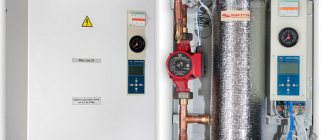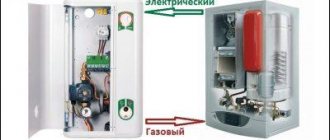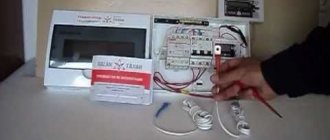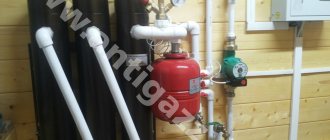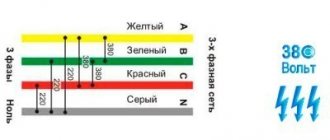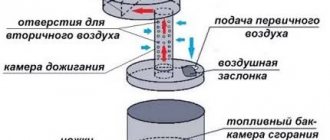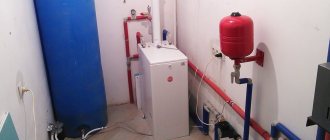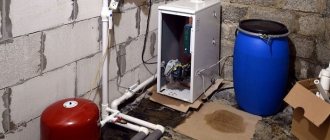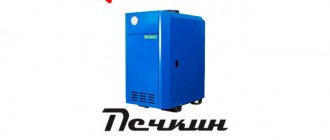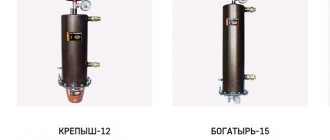Electric boilers are almost ideal in terms of comfort, practicality and reliability; they are easy to set up and require virtually no human intervention during operation. In addition, in addition to the lower initial cost of the boiler, the installation cost is also minimal: the boiler room is not required, there is no need for a chimney, supply and exhaust ventilation, or complex piping.
However, the main disadvantage, which often outweighs all the advantages, is the cost of heating a house with electricity. To heat a house with an area of 100 m2 in winter, you will need up to 13-18 thousand rubles. It is also worth considering that for houses with an area of more than 60-70 m2, a boiler operating from a three-phase (380 V) electrical network will be required, since the power of a standard two-phase (220 V) electrical network will simply not be enough. Electric boilers with a power of over 10 kW require approval from the Energonadzor services.
The most economical electric boiler is a myth
Electricity is much easier to convert into heat than other energy sources - natural gas, solid fuel, diesel fuel. Here are 3 simple examples of heat by-products when using electricity:
- the windings of any operating electric motor always heat up;
- a light bulb (even an LED one) produces heat along with the light;
- Even the wires through which current flows become heated.
Please note that the equipment listed is designed to perform its functions, and not to heat the house. The motor rotates something, the lamp shines, the wiring supplies them with energy. The formation of excess heat is a side effect that occurs due to the resistance of these elements.
Spiral and induction heater converting electricity into heat with 99% efficiency
To convert all electrical energy into thermal energy, it is enough to create a high resistance section in the circuit, which itself will not collapse from heating. This element is called an electric heater. The second (more complex) way to obtain heat is to create Foucault induction eddy currents that heat a metal object in the area of action of the inductor coil.
Important point. Regardless of the conversion method, 98–99% of electricity will turn into heat. That is, any electric heating device operates with an efficiency of 98–99%, no less. This means that the most economical electric boiler does not exist; all units are equally efficient. No matter what home appliance sellers claim.
The best single-circuit models
1
Protherm Skat 9 KR 13
RUB 33,500
Designed according to the all-inclusive system, can be used in three-phase and single-phase networks. The coolant can be either antifreeze or distilled water. The presence of a smooth regulation system allows you to avoid problems with sudden voltage changes. In addition, the model is equipped with several more degrees of protection. This is one of the best options for a small private home.
9.8 /10
rating
Advantages
- You can connect underfloor heating
- Clear controls
- Efficiency
Flaws
- No voltage stabilizer
Protherm Skat 9 KR 13
2
EVAN Warmos-IV-5
18,000 rub.
A good, inexpensive and economical option that can be installed in a private home. The insufficiently high, at first glance, power indicators are compensated by the capabilities of the heater, because the device is capable of not only maintaining heat at a certain level, but also has the ability to connect to a “warm floor” system. The device has a stylish design that will fit into any interior.
9.7 /10
rating
Advantages
- Anti-freeze function
- Protection against network surges
- Antifreeze can be used
Flaws
- Low power
EVAN Warmos-IV-5
3
Vaillant eloBLOCK VE 12
33,000 rub.
Thanks to its simple setup and control, such a boiler is suitable for those homeowners who do not want to delve into how it works and select the optimal mode, but want to get a unit that will work right away. The power of Vaillant eloBLOCK VE 12 at 12 kW is enough to heat a room up to 120 sq. meters, but it only works from a three-phase network. Two heating elements provide smooth heating and save energy. Can be used with a “warm floor” system.
9.5 /10
rating
Advantages
- Safe
- Simple controls
- Full set
Flaws
- No voltage stabilizer
Vaillant eloBLOCK VE 12
Selection of heat generator by power
To select the power of an electric boiler, first of all, calculate the heat losses of your home. You probably know the approximate method of calculation: to heat 100 square meters of building area, a heating unit with a capacity of 10 kW is taken, for 200 m² - 20 kW, and so on. If you want to get a more reasonable result, use our calculation methods.
A very approximate calculation method - we divide the area of all rooms by 10, we get heat loss in kilowatts
Now let’s define the tasks that an electric boiler must solve (select the desired list item):
- round-the-clock heating of an apartment, cottage, country house;
- the same, with water heating for domestic needs;
- work at night at a cheap rate;
- standby heating – maintaining the air temperature +5…10 °C.
Note. Night heating of the house with an electric boiler can be combined with heating of the heat accumulator. At 7.00 the unit turns off, then the water system receives the heat accumulated in the buffer tank. 2 conditions: the allocated limit for electricity consumption must be 15...20 kW + powerful electric boiler.
Full heating with electricity is not cheap and is used as needed. A more profitable option is night heating from 23.00 pm to 7.00 am, when the cost of energy is half as much. The standby mode is used on objects under construction or dachas, where the owners spend 2-3 days weekly.
We select the power of the electric heating boiler depending on the tasks:
- For round-the-clock operation, the unit is selected with a margin of 10...20%. That is, the heat loss figure is multiplied by a factor of 1.1–1.2. For example, a house with an area of 60 square meters loses 4 kW, the productivity of the electric boiler will be 4 x 1.2 = 4.8 kW.
- For hot water supply (DHW), the power of the unit should be increased by 50%. That is, multiply the figure 4 kW from the example by a factor of 1.5 (we get 6 kW).
To obtain hot water, it is customary to connect a single-circuit electric boiler to an indirect heating boiler through a three-way valve. The latter switches the coolant between the tank and the heating system - An electric heating device for night heating can be taken without a power reserve if it is replaced in the morning by a gas or solid fuel boiler. Reducing the temperature to 18–19 °C during sleep will not cause much discomfort, but will save money.
- The power of the electric boiler that maintains positive temperatures in the building is taken with a reduction factor of 0.6–0.7 (minus 30–40%) of the amount of heat loss.
Advice. To organize DHW, you do not need to look for a double-circuit boiler. Usually there are 2 options: installing a separate electric water heater or a powerful heat generator plus an indirect heating boiler.
The performance of the heater for nightly “charging” of the heat accumulator depends on the volume of the tank and is calculated individually. The selection of an electric boiler under standard conditions is described in the video:
Heating options
If it is possible to connect to the gas mains, we recommend choosing a gas boiler without hesitation, even despite the complex process of its registration. Otherwise, from an economic point of view, electric heating boilers are not always justified.
Electric boilers are compact in size, require a minimum of wiring and have a modern design, which allows them to be installed anywhere.
The most financially profitable option is to temporarily use an electric boiler. For example, at a dacha or in a second country house, where the owners come only from time to time, but do not live permanently. In such cases, the 1.5-3 times lower initial cost of the boiler, its installation and connection will cover the cost of electricity during operation for a long time.
Since all electric boilers (with the exception of induction) are designed to use exclusively water as a coolant, which freezes at subzero temperatures, it would be desirable in such a situation for the boiler to have the ability to connect external control. For example, using a GSM module or Wi-Fi module. Firstly, this will allow you to control the electric boiler remotely and set the desired temperature before arriving at the house. Secondly, remote control will give you confidence that in the absence of the owners the boiler maintains a positive temperature and the system is not damaged (otherwise you will immediately receive a notification).
Another great option is to use an electric boiler as an additional or backup heating equipment. For example, in a scheme using a buffer tank in case of problems with the operation of the main boiler and heating at a night tariff, or for a heated floor circuit. For such purposes, an inexpensive 3-6 kW electric boiler costing 11-15 thousand rubles, operating from a single-phase power supply, is quite sufficient. It will be able to maintain temperatures above +18°C in a house of about 100 square meters. m. for 2-2.5 days or completely ensure the normal temperature of the heated floor on an ongoing basis.
A simple and compact low-power model EVAN EPO.
Water-heating electric boilers can be used as the main heating equipment only if you have a free budget. The only exceptions are small and insulated houses with an area of up to 90-100 m2. To heat such an area, taking into account medium or dense insulation, an inexpensive electric boiler with a capacity of 6-9 kW will be sufficient. The low cost of the boiler unit and its installation, as well as the absence of the need for its coordination with Energonadzor services, will pay off the high operating costs for another 1-3 heating seasons.
Complete set of heating units
We have already listed the elements of any electric boiler in the basic, cheapest configuration. This is a heating unit, thermostat, automation with an actuator, controls and a temperature sensor.
An important nuance. In budget versions of boilers, the executive element is a magnetic starter. It clicks loudly when the heating is turned on, the sound is clearly audible in the rooms adjacent to the boiler room.
In an extended configuration, manufacturers supply electric boilers with the following equipment:
- low-noise modular contactor instead of a magnetic starter;
- circulation pump;
- membrane expansion tank for a closed heating system;
- overheating and coolant pressure sensors;
- safety group – automatic air vent, safety valve;
- circulation sensor – for induction heat generators;
- weather automatics;
- LCD display, programmer, GSM remote control module from a smartphone.
Naturally, the “fat” equipment of an electric boiler will cost much more than the “poor” one. On the other hand, you will still have to buy an expansion tank, a pump and a safety group. It is much more convenient to install the unit when these elements are hidden inside the housing.
Number of circuits
Construction of a double-circuit boiler.
When installing a heating boiler, you can provide your home with an uninterrupted supply of hot water, but the equipment for this must be selected especially carefully. In this case, it is necessary to make a choice between devices with one or two circuits. Single-circuit appliances allow you to organize only a heating system, since they are not designed to heat water, which is supplied to the user through taps in the kitchen or bathroom. If there is a need for this, you need to choose double-circuit gas boilers. There is a separate classification here: gas boilers are produced as wall-mounted, floor-mounted, flow-through and with large storage tanks.
Which boiler should you choose? You must first decide what functions are required from the equipment. For example, single-circuit devices are capable of supplying coolant for heated floors.
Flow-type equipment is used when almost instantaneous heating of water is required, and they pump 10-15 liters through themselves in a minute, heating this volume to the set temperature.
Double-circuit heating boilers have additional tanks with a certain capacity. They contain a volume of already hot water, but when supplied it may not always be immediately hot, and this leads to liquid consumption. Therefore, the choice must be made based on how economical and effective the equipment is, and whether it fully meets all operating requirements.
Which electric boiler to choose - recommendations
In 90% of cases, we recommend choosing an electric boiler with heating elements. These are reliable devices that are equally suitable for different heating systems - radiators, heated floors, floor or baseboard convectors. Select the level of staffing based on the conditions of installation, operation and the allocated budget.
A few more tips:
- For your apartment, definitely take a wall-mounted electric mini-boiler room, equipped with heating elements, its own pump and tank.
- If the electric boiler must work in tandem with a solid fuel or gas unit, it is better to choose a model without a built-in pump and expansion tank. The specified equipment is connected separately - the tank works for the entire system, the pump is controlled by a room thermostat, as shown in the diagram.
It is more convenient to operate the circulation pump when it is located separately from the boiler - Install a remote thermostat. Then the boiler will focus on the temperature of the air, and not the coolant.
- Choose an electrode heat generator in 3 cases: limited budget, too little space in the boiler room, or connection to a gravity heating circuit without a pump.
- Electrode units create the least problems in open systems - the resulting gases safely escape through the atmospheric expansion tank.
- Choose an induction boiler according to your desire and availability of funds. But keep in mind: operating experience has shown that the specified device is no better than a heating element. No special technical problems were noted with induction heaters, only financial ones.
Comment. An electrode-type boiler for a gravity system must have pipes of the appropriate diameter (minimum Ø32 mm), the supply pipe is directed upward.
For a water heated floor, only an electric heating element boiler is suitable. It is difficult for induction and electrode units without stepwise heating to maintain a low water temperature in floor circuits - 35...45 °C.
Reviews of household electric boilers: advantages and disadvantages
| Advantages | Flaws |
| Easy to install and connect. You can install an electric boiler without any special skills; moreover, it does not require a chimney, ventilation system, or boiler room. From the piping - only the supply and return lines (and the DHW circuit in dual-circuit models). | The highest operating costs among all types of boilers. According to operating practice and reviews from owners, even the most energy-saving models and proper use of a room thermostat will not reduce costs to the cost of heating with gas, wood or liquid fuel. |
| Compact sizes. Heating element models have smaller dimensions than gas and liquid fuel wall-mounted counterparts. Compact electric boilers in the form of a flask with a heating element or ionic models barely exceed the diameter of the heating system line. | Models with power over 6 kW require connection to a more powerful three-phase power supply (380 V). Electrical equipment with a power of more than 10 kW requires approval from local Energy Supervision services. |
| Autonomy and convenience. Electric boilers are almost ideal in this regard, since they can work for weeks and months without human intervention. Almost all models have the ability to connect external thermostats. | When using an electric boiler as the main heating equipment, the heating system becomes completely dependent on the power supply. If there are any interruptions, the house may be left without heat. |
| Safety and environmental friendliness. Electric boilers do not produce emissions, there is no open fire, and all models have overheating protection. | Powerful electric boilers create a significant load on the electrical network of the house. Therefore, they require high-quality and serviceable wiring. |
| Low cost of equipment and its installation. | |
| Almost silent operation. | |
| Availability of both single-circuit and double-circuit models. | |
| Low maintenance requirement, simple and reliable device, in which many components have an almost unlimited resource. |
Finally, about energy consumption
The natural desire of a homeowner is to know how much electricity an electric boiler will consume when heating a private home. Unfortunately, actual consumption cannot be predicted. The indicator is too individual and depends on a number of factors - the degree of insulation, the temperature maintained inside, the weather.
Monthly consumption can be calculated approximately: take 50% of the estimated heat loss of the house, multiply by 24 hours and 30 days. Example: losses are 6 kW, half - 3 kW, per day 3 x 24 = 72 kW, per month - 72 x 30 = 2160 kW. Why we take ½ power: during the season the weather is not always cold, the warmer it is outside, the more often the electric boiler turns off.
An example from personal experience. A house of 100 m² is heated at night with a 9 kW electrode boiler for 8 hours, the region is southern. Over 6 months of the heating season, the electric boiler consumed 9104 kW. Average monthly energy consumption is 1517 kW, average daily energy consumption is 1517 / 30 = 50.6 kW.
Method 7 - infrared heaters (the most economical)
Infrared heaters are considered the most economical of all types of electric heaters. They do not need heating elements and water pipes. Infrared heaters heat objects, not the room. Then the heated objects heat up the air. If an electric boiler can be compared to a kettle, then an infrared boiler can be compared to a microwave oven.
Infrared panels are especially popular. They are installed on the ceiling or walls of residential and industrial premises. Since the heating area is increased, the room becomes warmer faster than usual. Such a panel can be used as an independent heating source or as an addition to an existing system. An infrared heater goes well with electrode boilers. For example, an infrared heater can only be turned on in spring and autumn, when it is too early to turn on the main heating, or when it suddenly gets cold outside.
Pictured is a GROHE infrared panel, Germany
Conclusion
Heating with electricity is unprofitable - only diesel fuel is more expensive. But if it is possible to implement a scheme with a heat accumulator, the energy resource's costs will reach the level of coal and will be comparable to natural gas (the difference will be 25%). This makes sense, especially when you consider the many benefits of electric heating. In any case, each user decides for himself whether to install an electric boiler or convectors as an alternative.
